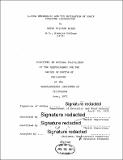L-dopa metabolism and the regulation of brain polysome aggregation
Author(s)
Weiss, Bette Fishman.
Download1393108184-MIT.pdf (35.23Mb)
Other Contributors
Massachusetts Institute of Technology. Department of Nutrition and Food Science.
Advisor
Hamish N. Munro and Richard J. Wurtman.
Terms of use
Metadata
Show full item recordAbstract
Intraperitoneal administration of L-dopa {50-300 mg/kg) caused a marked disaggregation of brain polysomes in immature rats {15-20 g body weight). Polysome disaggregation was maximal between 40 and 60 minutes after injection and not significant at 20 and 120 minutes. Older rats {50 and 100 g body weight) showed a similar response, but required larger doses of the amino acid {500 mg/kg). Disaggregation could not be sustained in 100 g rats by chronic single injections of 500 mg/kg per day for 10 days; disaggregation occurred only if the last dose of L-dopa was 1 hour before·sacrifice. Polysome disaggregation after oral L-dopa was achieved in. 100 g rats if the dopa administered was very high {3 g/kg) and the time after administration was increased to 90-120 minutes. Brain polysomes may be unique in their response to L-dopa, as neither rat liver nor skeletal muscle showed a change in polysome aggregation after L-dopa injection. To determine the mechanism of L-dopa on polysome disaggregation, the metabolism of L-dopa in the brain was examined. Single i.p. doses significantly elevated tryptophan content in the brain at the three ages of rats examined; hence the effect of L-dopa on polysomes did not result from the unavailability of this amino acid. No other amino acid was depleted after L-dopa administration to account for brain polysome disaggregation. The effects of intraperitoneal L-dopa and related drugs on brain polysomes and dopa metabolism were compared in 50 g rats to determine which subsequent metabolic pathway within the brain was responsible for the polysome disaggregation. At the time after L-dopa when polysome⁻ disaggregation occurred there were increased brain dopa, 3-O-methyldopa levels and a depletion of S-adenosylmethionine. There was a four-fold increase in dopamine and a small, insignificant increase in norepinephrine. The disaggregation of brain polysomes in rats after L-dopa administration was not reproduced by administering its metabolite 3-0-methyldopa, nor by giving D-dopa. D-dopa also depleted the brain of S-adenosylmethionine, to synthesize 3-0-methyldopa, but was not converted to catecholamines. Polysome disaggregation did not take place when L-dopa was given after a decarboxylase inhibitor;. there was no increase in dopamine when L-dopa was administered after the inhibitor, although the concentration of dopa in the brain was four times the level attained with L-dopa injection alone. These experiments suggested that formation of a catecholamine was an obligatory requirement for polysome disaggregation in the brain after L-dopa. Polysome disaggregation did not occur when dopamine or norepinephrine were administered intracisternally. However, polysome disaggregation was potentiated when 100 mg/kg L-dopa, a dose that alone did not disaggregate polysomes, was given after a monoamine oxidase inhibitor. Blocking one route of catecholamine metabolism, by this inhibitor resulted in a much higher level of catecholamines in the brain than expected after this dose of L-dopa alone; the dopamine concentration was equivalent to that after 500 mg/kg L-dopa alone. These observations suggested that the mechanism by which L-dopa disaggregated brain polysomes involved its conversion to dopamine within the majority of brain cells. The responses of brain polysomes and brain tryptophan to L-dopa administration to rats were apparently unrelated, because the dose responses and time courses of these phenomenon were different. Tryptophan levels rose before and remained elevated after polysomes were disaggregated. Administration to 50 and 100 g rats of low doses of L-dopa, that could not disaggregate brain polysomes, elevated brain tryptophan content. The increase in brain tryptophan content after L-dopa occurred with a concurrent larger increase in plasma tryptophan level. The plasma tryptophan rise was not due to an alteration in plasma insulin level, nor could it be attributed to a decrease in liver or skeletal muscle tryptophan content. Except for increases in tryptophan and dopa, no plasma amino acid level was altered in rats after L-dopa. The increase in brain tryptophan content was no longer seen in 100 g rats treated with chronic single injections of 100 mg/kg per day, and if the last dose of L-dopa was one day before sacrifice, brain tryptophan content declined.
Description
Thesis: Ph. D., Massachusetts Institute of Technology, Department of Nutrition and Food Science, 1972 Cataloged from PDF version of thesis. Vita. Includes bibliographical references (pages 140-151).
Date issued
1972Department
Massachusetts Institute of Technology. Department of Nutrition and Food SciencePublisher
Massachusetts Institute of Technology
Keywords
Nutrition and Food Science.